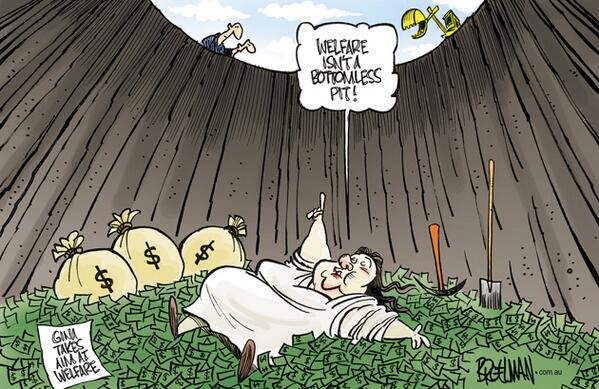Search
Democracy Links
Member's Off-site Blogs
the world according to turd-blossom ...

She’s at it again.
It’s election time so out rolls Gina Rinehart to give her opinion/edict about what must be done.
Mining magnate Gina Rinehart says Australian politicians don’t “have the guts” to tackle government spending.
Ms Rinehart said the cost of government was growing rapidly and this issue has been overlooked in the election campaign.
“There is one giant cost slab that isn’t decreasing: government,” Ms Rinehart told the Saturday Telegraph.
If we are looking to save money, the first place I would cut government spending is in the billions they hand out in corporate welfare to Gina and her mining mates.
In 2013, the PBO determined that $13 billion could be saved over the forward estimates by abolishing the concessions given to miners.
In 2014, The Australia Institute calculated that, over a six-year period, state governments in Australia spent $17.6 billion supporting the mineral and fossil fuel industries. Queensland’s assistance was by far the largest of all states, totalling $9.5 billion, followed by Western Australia’s at $6.2 billion.
This assistance takes many forms. Sometimes it is a direct cash payment. For example, the New South Wales government gave multinational coal companies $10 million in 2009 as an ‘assistance package’.
Other times it comes in the form of discounted access to services provided by the state and its businesses – Queensland has provided the coal industry with ‘concessions’ on access to rail services worth over $1 billion between 2012-13 and 2013-14.
Often assistance comes in the form of infrastructure or projects that wholly or partly benefit the minerals and fossil fuel industries.
At the federal level, The Australia Institute publishes an annual study on subsidies of the mining industry, which totalled $4.5 billion in 2013, up from $4.0 billion in 2012.
Gina also took aim at the level of government red tape she claims obstructs industry developments.
“India has the guts to do what it’s doing to cut at least federal red tape, with the consequent immense benefits to its people, driving investment, jobs, economic growth and living standards – why can’t Australia?” she said.
Mining has the distinction of being the most dangerous profession in India. Every ten days last year there was a mining fatality. And every third day last year, on an average, there was a serious accident in the coal mining sector.
India produces 89 minerals by operating 569 coal mines, 67 oil and gas mines, 1,770 non-coal mines, and several more small mines, all of which translate into direct employment of about 1 million on a daily average basis and an overall sector contribution of about 5 per cent to the country’s gross domestic product.
However, the fact that disasters strike at regular intervals in coal mines and some of the metalliferous mines — iron ore, soapstone and granite mines — is a pointer to the Indian mining industry’s abysmal safety record and the failure of its utilities to learn from the ‘standard operating procedures’ (SoPs) implemented in countries such as Australia, the US and even China.
Plus, the frequency of incidents has increased in recent years, as flagged by the National Human Rights Commission (NHRC) in its 2014 report titled ‘Views on Mine Safety in India’.
But for Gina it’s all about her. She says her $10 billion iron ore project at Roy Hill has been slowed down by the around 400 government approvals needed.
Gina doesn’t care about Australia. To secure the loan for her Roy Hill mine from an American bank, she contracted to use US steel and mining machinery, a decision which the bank said would create thousands of jobs – in the US.
Imagine if those contracts had gone to Arrium in Whyalla and to Caterpillar in Tasmania. Imagine if Gina had chosen to employ Australians instead of importing 1700 457 visa workers to exploit. Imagine if Michaelia Cash had actually done something about the union’s revelations.
Gina likes to tell us she is making a huge personal contribution to Australia but the reality is that Gina looks after Gina and nobody else, with the possible exception of her dear friend Barnaby Joyce.
Gina wanted the carbon and mining taxes gone. Done. Gina’s ANDEV group, in conjunction with the IPA, wanted dams. Barnaby’s on it. They wanted a development fund for Northern Australia. Done. They wanted a special economic zone so they can pay even less tax. A work in progress.
Gina bought dairy farms and cattle stations. Some months later the Chinese Free Trade Agreement is signed with significant concessions for the dairy and beef industries.
This woman uses her vast wealth to buy political and media influence. She can afford to fund misleading advertising campaigns. She has no concern for the thousands of mining jobs that are being lost.
If the government is to cut spending, let’s start with the corporate welfare queen.
The gargantuan greed of Gina Rinehart
- By John Richardson at 19 Jun 2016 - 3:39pm
- John Richardson's blog
- Login or register to post comments
Recent comments
2 hours 52 min ago
2 hours 55 min ago
3 hours 22 sec ago
4 hours 25 min ago
5 hours 31 min ago
5 hours 48 min ago
5 hours 55 min ago
6 hours 2 min ago
19 hours 30 min ago
21 hours 30 min ago